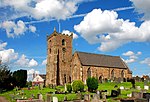Groby

Groby (pronounced "GROO-bee" ) is a village in the Hinckley and Bosworth borough Leicestershire, England. It is to the north west of Leicester. The population at the time of the 2011 census was 6,796.The village saw a huge expansion during the 1970s along with the village of Glenfield. The historic village centre retains some of its historic buildings, cobbled lanes and thatched cottages. The church of St Philip and St James, built in the lancet style by George Harry Booth-Grey, the sixth Earl of Stamford, dates from 1840 and stands in the grounds of Groby Castle. The architect was William Railton. Additionally the village was also home to the former Groby Old Hall, the stone-built parts of which are thought to have been part of the castle's outer buildings.
Excerpt from the Wikipedia article Groby (License: CC BY-SA 3.0, Authors, Images).Groby
Ratby Road, Hinckley and Bosworth Groby
Geographical coordinates (GPS) Address Nearby Places Show on map
Geographical coordinates (GPS)
| Latitude | Longitude |
|---|---|
| N 52.65824 ° | E -1.23267 ° |
Address
Ratby Road
LE6 0BS Hinckley and Bosworth, Groby
England, United Kingdom
Open on Google Maps








